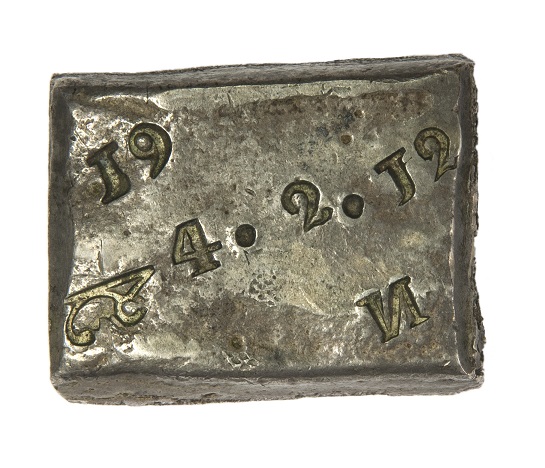The Central Bank of Malta recently acquired a rare silver ingot, dating back to the French period in Malta. After decades of obscurity, the ingot will go on display for the first time, during the anticipated Notte Bianca event on 4 October, 2014 at the Central Bank of Malta, as part of the Bank’s numismatic display.
In May, 1798 Napoleon Bonaparte, at the head of an invasion army, embarked from the French port of Toulon bound for Egypt. En route, the French fleet stopped in Malta and requested access to the Grand Harbour to replenish its supply of water. The Order of St John refused to let the French ships enter the Grand Harbouren masse. Napoleon used this as a pretext to launch his premeditated invasion of Maltaon 9 June, 1798. Amidst betrayal and confusion, the Order’s feeble defence collapsed and the island surrendered after three days.
Between 12 and 18 June, 1798, Napoleon spent seven eventful days in Malta. During this period, various laws were promulgated, which were to lead to a complete overhaul of the local administration and institutions to bring them in line with the French republican model. Widespread fundamental changes affected all strata of Maltese society and were the cause of much dissent.

On 2 September 1798, the Maltese revolted against the French, who were blockaded inside Valletta and the fortified cities of Cottonera. Following this, the French commanding general, Vaubois, stripped the Monte di Pieta of all its money and pawns, which at the time amounted to 443,484 scudi, to maintain the French garrison and the inhabitants of Valletta during the blockade.
At the time, the French authorities in Malta were facing an acute shortage of coinage. In his diary of the blockade, Bosredon Ransijat wrote that “the minting of coins had to be suspended owing to the lack of certain objects indispensable to continue the striking of these”. Vaubois therefore decided “to manufacture ingots, the intrinsic value of which was to correspond exactly to that which they purported to represent and which would thus not cause any loss to those who wished to exchange them in whatever country they found themselves in”.
In January/February of 1799,Vaubois ordered the gold and silver seized from the Monte di Pieta to be melted and cast into bars. The bars were then divided into small ingots, each of which was stamped with its intrinsic value in scudi, tari and grani diagonally across the centre.
According to a statement by Joachim Lebrun, the Master of the Mint, the first casting of gold bars took place on 5 February 1799. A total of 28 ingots of different weights were produced, which amounted to around 10,046 scudi. It appears, however, that the ingots from the first casting were never put into circulation as currency.

A second casting of gold ingots took place on 8 July 1799. In this operation 376 small gold ingots were cast, with a total value of around 30,806 scudi. It is recorded that 364 were issued in circulation and 12 were retained to meet the expenses of the Master of the Mint. All the ingots from this casting bear the alphabetical letter “I”.
The 3441 lbs of silver confiscated from the Monte di Pieta were melted and converted into 4285 ingots, for a total value of around 80,834 scudi. The first casting of silver ingots took place on 16 April 1799. In all there were 14 casting operations, each of which was identified by a different letter from “A” to “P” (letters “I” and “J” were not used on silver ingots). The casting operation letter was stamped on the upper corner of the ingots.
All the ingots were stamped with a lion rampart in an oval frame. The edges where the ingot had been removed from the bar were stamped with paschal lamb to prevent fraud.
Although the exact intrinsic value was stamped on the ingots, there were instances when these unusual and crude forms of money were refused or accorded a lower value by profiteers. To stop such practices Vaubois issued a proclamation on 24 April, 1799 in which he declared that ingots had to be received and exchanged as money at the value imprinted on them. Refusing the ingots, according them a lower value, or refusing to give change when payments were made in ingots, became an offence which incurred a penalty equal to the value of the ingot refused.
Only one gold and seven silver ingots have remained from all the ingots produced by the French during the blockade. The gold ingot and two silver ingots form part of the National Collection of Malta. A further silver ingot is held in the collections of the British Museum and another two silver ingots are found at the museum of the Venerable Order of St John at Clerkenwell, UK. In 1903, BrauseManfeld recorded another silver ingot, and in 1956 Victor Denarofound another silver ingot, which had been in the collection of Angelo Galea of Mosta.
The public is invited to view this unique testimony to a very short but troubled period in Maltese history at the Central Bank of Malta during Notte Bianca.
History by Kevin Cassar, Curator of the Numismatic Collection at the Central Bank of Malta during Notte Bianca